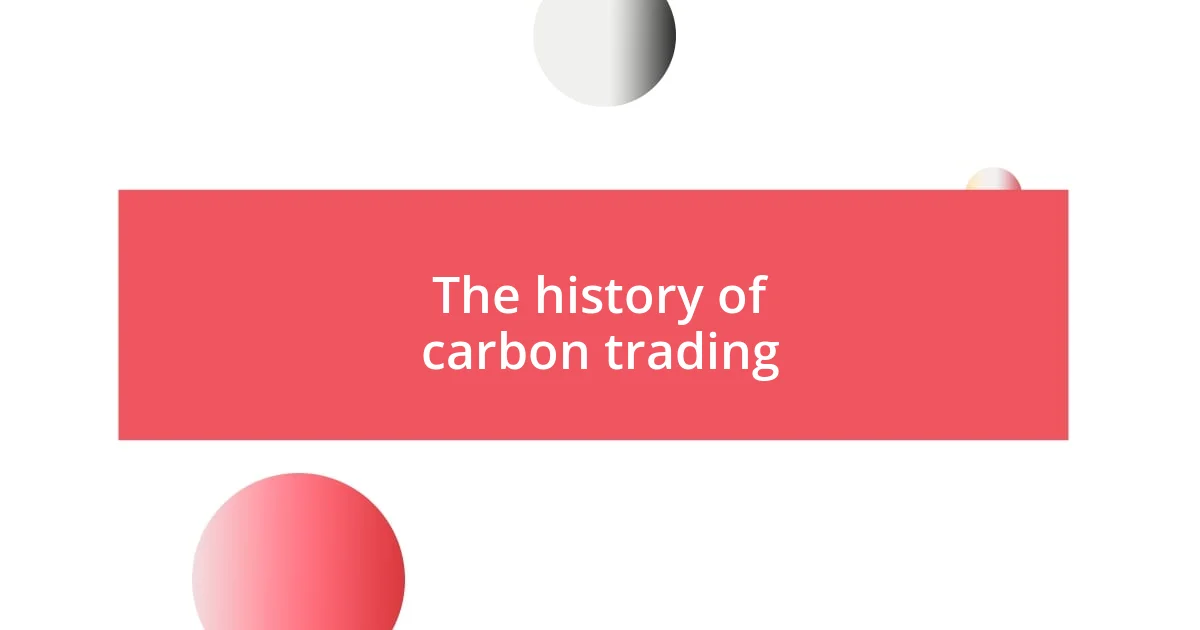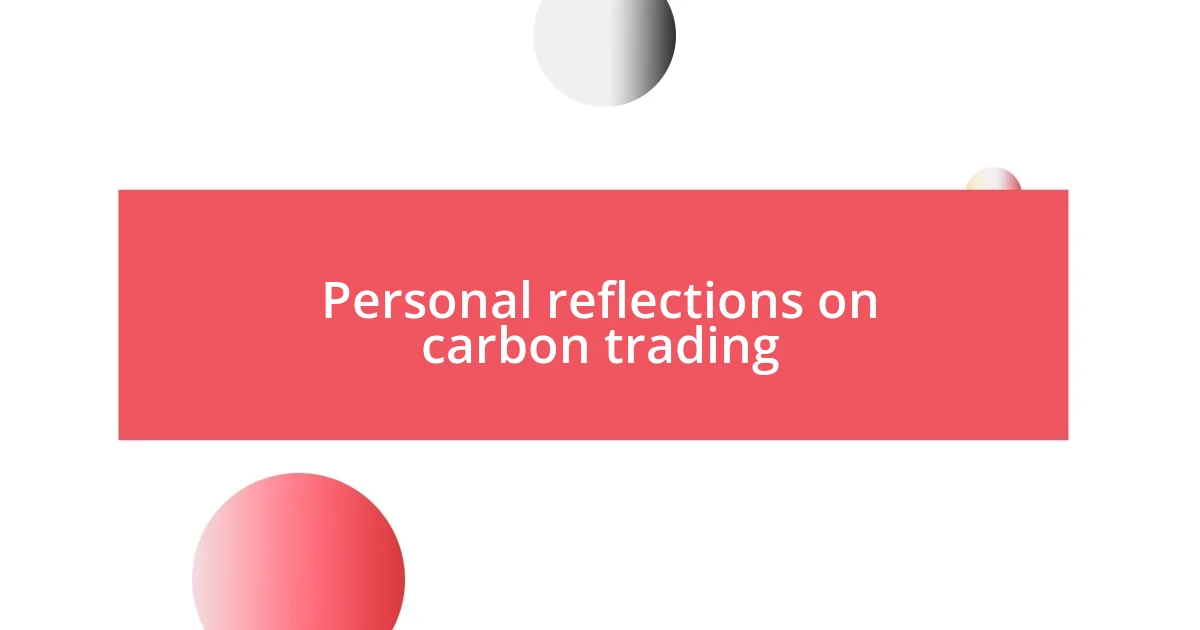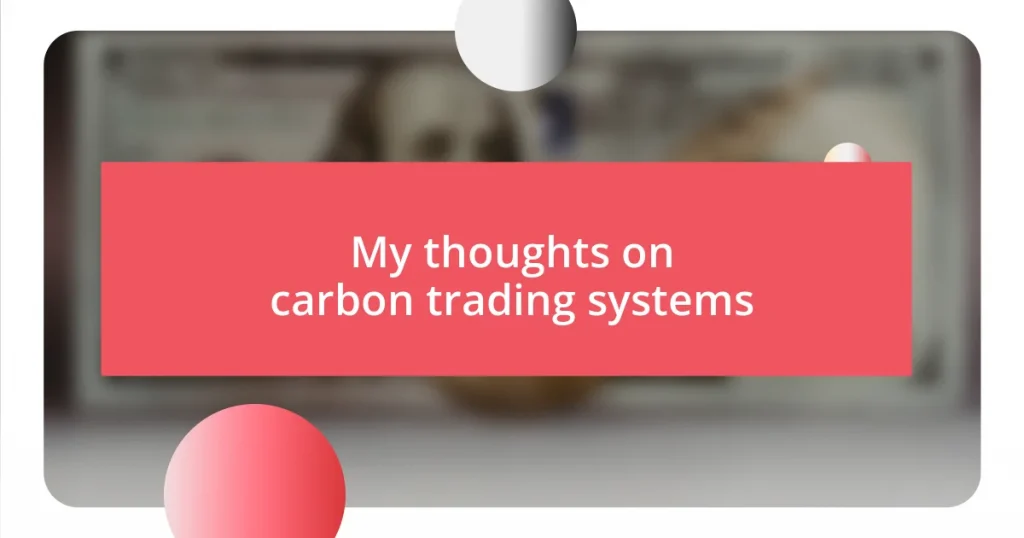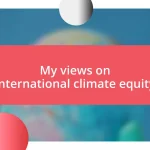Key takeaways:
- The concept of carbon trading began with the UNFCCC and was formalized by the Kyoto Protocol in 1997, leading to regional cap-and-trade programs like the EU ETS in 2005.
- Carbon credits represent one metric ton of CO2 emissions reduced and can be traded in a market, helping to incentivize green practices while ensuring accountability through monitoring and penalties.
- Future trends in carbon trading include technological integration for transparency, expansion into new sectors like agriculture, and increased governmental regulation to drive innovation and sustainability.

Understanding carbon trading systems
Understanding carbon trading systems can sometimes feel overwhelming, but at its core, it’s about creating a market for carbon emissions. I often think of it like a giant scoreboard, where companies earn and trade credits based on their ability to reduce or limit emissions. It’s fascinating how this system transforms something intangible like air quality into a tradable commodity.
When I first learned about cap-and-trade systems, it struck me how they blend economic incentives with environmental goals. Imagine a business weighing the cost of investing in green technology against the potential savings from selling excess credits. It’s a balancing act that can drive innovation, but are we truly leveraging this potential? Sometimes, I wonder if companies are genuinely committed to sustainable practices or just playing the system to boost their bottom line.
Participation in carbon trading can also evoke a sense of community responsibility. I remember attending a local meeting where stakeholders discussed their strategies for reducing emissions, and the passion was palpable. Engaging with diverse perspectives made me realize that carbon trading isn’t just about profits; it’s about the collective effort to combat climate change. What motivates you to get involved in sustainability efforts? Recognizing this connection can deepen our commitment to the environment.

The history of carbon trading
The inception of carbon trading systems can be traced back to the early 1990s, specifically with the United Nations Framework Convention on Climate Change (UNFCCC). I recall watching the discussions during the Earth Summit in 1992, where countries began to acknowledge the urgent need to tackle climate change. This event culminated in the Kyoto Protocol of 1997, which introduced the concept of emissions trading—paving the way for the structures we see today. It’s incredible how policy can shape our approach to environmental issues, isn’t it?
As time progressed, various regions implemented their designed cap-and-trade programs. For instance, the European Union launched its Emissions Trading System (EU ETS) in 2005, which I found to be a significant step in unifying efforts toward a greener economy. This program became a model for others, proving that collaborative efforts could lead to tangible reductions in carbon emissions. The most striking part for me was seeing how businesses adapted, investing in cleaner technologies while trying to balance their economic ambitions.
The history of carbon trading systems highlights the ongoing shift toward sustainability and its challenges. The discussions and debates surrounding these frameworks have evolved significantly. I remember feeling a mix of hope and skepticism when observing countries renegotiate commitments, especially during COP meetings. Have we truly gained enough momentum? The progress is evident but slow; I’m often left pondering how deeply committed we are to the green transition.
| Year | Significant Events |
|---|---|
| 1992 | UN Earth Summit where climate change was first addressed |
| 1997 | Kyoto Protocol introduced emissions trading concepts |
| 2005 | Launch of the EU Emissions Trading System |

How carbon credits work
Understanding how carbon credits function reveals the intricate mechanism behind carbon trading systems. Each carbon credit represents one metric ton of carbon dioxide (CO2) emissions that a company has reduced or avoided. I find it fascinating how companies can accumulate credits by investing in renewable energy or improving energy efficiency. This not only incentivizes green practices but also creates a market dynamic, motivating businesses to engage in environmental stewardship.
Here’s a brief breakdown of how this system operates:
- Credits Creation: Companies generate carbon credits by implementing eco-friendly practices or technologies that decrease emissions.
- Market Trading: These credits can be sold or traded, allowing those who exceed their emission targets to profit from their efforts.
- Monitoring and Verification: Third-party organizations verify emissions reductions, ensuring that credits represent actual environmental benefits.
- Compliance and Penalties: Companies are required to hold enough credits to cover their emissions; failing to do so can result in monetary penalties.
From my perspective, this system helps bridge the gap between environment and economy, allowing businesses to find a profitable path towards sustainability.

Benefits of carbon trading
The benefits of carbon trading systems are vast and multifaceted. One major advantage is the financial incentive for companies to reduce their emissions. I’ve seen businesses transform their operations, investing in cleaner technologies simply because it could save them money on carbon credits. Isn’t it remarkable how market forces can drive positive environmental change while still considering economic realities?
Moreover, carbon trading creates a collaborative environment where companies can share innovative solutions. I remember attending a conference where different businesses showcased their emission-reduction strategies, exchanging ideas that could benefit everyone. This spirit of cooperation can lead to breakthroughs that individual companies might not achieve on their own. It’s satisfying to think about how these interactions can significantly impact our collective carbon footprint.
Finally, carbon trading helps to establish a clear benchmark for emissions reduction. When I first encountered the concept of allowances and caps, it struck me how tangible it made the invisible issue of climate change. Setting a quantifiable limit forces companies to take responsibility, nurturing a culture of accountability. Don’t you feel like this clarity is crucial in motivating action?

Challenges of carbon trading systems
One of the most significant challenges of carbon trading systems is ensuring fairness and accuracy in the allocation of carbon credits. I remember a discussion I had with a friend who works in environmental policy; she mentioned how larger corporations often have an advantage because they can invest heavily in technologies that smaller companies simply can’t afford. This discrepancy can lead to a situation where responsibility and benefits are unevenly distributed, creating resentment among smaller players in the market.
Additionally, the complexity of monitoring and verifying emissions reductions can be overwhelming. During a workshop I attended, experts shared their frustrations with the time and resources needed to confirm reductions. It made me realize that if the verification process is flawed, it undermines the entire premise of carbon trading. How can companies be held accountable if the measurement tools are not robust? This concern resonates deeply with me; transparency and trust are crucial for any system to succeed.
Another challenge lies in market volatility. I have seen firsthand how fluctuating carbon prices can create uncertainty for businesses. In one instance, a startup I was advising faced financial difficulties when credit prices dropped unexpectedly. This unpredictability can discourage long-term investments in sustainable practices. Isn’t it ironic how a system meant to promote environmental stability can sometimes create chaos? Addressing these challenges is essential for the effectiveness and longevity of carbon trading systems.

Future trends in carbon trading
The future of carbon trading promises to evolve significantly, especially as more countries commit to net-zero goals. I’ve observed a growing movement toward integrating technological advancements such as blockchain for transparency in transactions. Isn’t it exciting to think that these tools could enhance trust in the system and encourage wider participation?
Another trend I foresee is the expansion of carbon trading markets beyond traditional sectors. For example, I participated in a forum recently where speakers highlighted how agricultural practices could be included in these systems. The possibility of farmers generating carbon credits through sustainable practices reflects a broader understanding of who can contribute to emissions reductions. Just imagine how empowering that would be for those communities!
Finally, I think we’ll see more governmental and regulatory involvement shaping carbon trading. From my experience, policy adjustments can sometimes feel like a double-edged sword, both creating challenges and offering solutions. As regulations become stricter, wouldn’t it be fascinating to watch businesses innovate to stay ahead? This dynamic could lead to a more sustainable future, where carbon trading is not just a financial mechanism, but a crucial part of our climate strategy.

Personal reflections on carbon trading
Reflecting on my journey with carbon trading, I can’t help but feel a mix of hope and skepticism. A few years back, I attended a conference that opened my eyes to the potential of these systems. Listening to passionate speakers share success stories hit home for me. It’s inspiring to see how businesses can drive change, but I wonder—does that change truly benefit everyone involved?
I remember an instance when I was chatting with a local entrepreneur who had big dreams of launching an eco-friendly product line. She was excited about participating in a carbon trading scheme to offset her startup’s emissions. But then she confided in me about her fears of getting lost in a crowded market dominated by larger players. It really struck me; what good is a system that encourages innovation if it simultaneously creates barriers to entry? This thought lingers whenever I consider the broader landscape of carbon trading.
Moreover, I often ponder the psychological aspect of trading carbon credits. It feels like a game at times, where companies calculate their moves as if they were playing chess. I vividly recall a late-night discussion with a group of scientists who expressed frustration over this mentality. The stakes in climate action are so high, yet here we are, strategizing over credits. Shouldn’t we be focusing on collaboration instead? In my view, the essence of carbon trading should promote unity in the fight against climate change rather than fostering competition.















